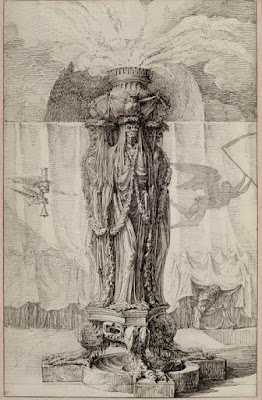 |
| Alessandro Algardi Design for a Funerary Monument before 1654 drawing Musée du Louvre |
 |
| Giovanni Francesco Romanelli Design for Architectural Decoration before 1662 drawing, with watercolor Musée du Louvre |
 |
| Ciro Ferri Ornamental Motif with David slaying Goliath ca. 1670 drawing Musée du Louvre |
 |
| Carlo Maratti Hommage to Raphael ca. 1675 drawing (study for print) Musée du Louvre |
 |
| Giacinto Brandi Design for a Banner with Pope Clement I and St Francis at the Foot of the Cross before 1691 drawing Musée du Louvre |
 |
| attributed to Pierre Puget Study for Equestrian Statue before 1694 drawing Musée du Louvre |
 |
| Ennemond-Alexandre Petitot Design for an Equestrian Statue ca. 1750 drawing Musée du Louvre |
 |
| Ennemond-Alexandre Petitot Design for Cartouche ca. 1750 drawing Musée du Louvre |
 |
| Jean-Charles Delafosse Temporary Decoration for Festival of Peace 1763 drawing Musée du Louvre |
 |
| Louis-Jean Desprez Design for Funerary Torch composed of Skeletons and Bats ca. 1770 drawing Musée du Louvre |
 |
| Johann Christian von Mannlich Design for a Tomb Relief with Hymen Mourning 1775 drawing Museum Kunstpalast, Düsseldorf |
 |
| Jacques Saly Study for a Funerary Monument before 1776 drawing Musée du Louvre |
 |
| Gabriel de Saint-Aubin Design for a Monument to Magistrates 1776 drawing Musée du Louvre |
 |
| Pietro de Angelis Design for a Trompe-l'oeil Ceiling Decoration ca. 1780 drawing National Gallery of Art, Washington DC |
 |
| attributed to Jean-Charles Delafosse Design for a Tureen before 1789 drawing Musée du Louvre |
 |
| François Masson Study for Ceiling Decoration 1795 drawing Musée du Louvre |
"The universal and absolute need out of which art, on its formal side, arises has its source in the fact that man is a thinking consciousness, i.e. that he draws out of himself, and makes explicit for himself, that which he is, and, generally, whatever is. The things of nature are only immediate and single, but man as mind reduplicates himself, inasmuch as prima facie he is like the things of nature, but in the second place just as really is for himself, perceives himself, has ideas of himself, thinks himself, and only thus is active self-realizedness. This consciousness of himself man obtains in a twofold way: in the first place theoretically, in as far as he has inwardly to bring himself into his own consciousness, with all that moves in the human breast, all that stirs and works therein, and, generally, to observe and form an idea of himself, to fix before himself what thought ascertains to be his real being, and, in what is summoned out of his inner self as in what is received from without, to recognize only himself. Secondly, man is realized for himself by practical activity, inasmuch as he has the impulse, in the medium which is directly given to him, and externally presented before him, to produce himself, and therein at the same time to recognize himself. This purpose he achieves by the modification of external things upon which he impresses the seal of his inner being, and then finds repeated in them his own characteristics. Man does this in order as a free subject to strip the outer world of its stubborn foreignness, and to enjoy in the shape and fashion of things a mere external reality of himself. Even the child's first impulse involves this practical modification of external things. A boy throws stones into the river, and then stands admiring the circles that trace themselves on the water, as an effect in which he attains the sight of something that is his own doing. This need traverses the most manifold phenomena, up to the mode of self-production in the medium of external things as it is known to us in the work of art. And it is not only external things that man treats in this way, but himself no less, i.e. his own natural form, which he does not leave as he finds it, but alters to set purpose. This is the cause of all ornament and decoration . . ."
– Georg Wilhelm Friedrich Hegel, from Lectures on Aesthetics (published posthumously, 1835-38), translated by Bernard Bosanquet (1886)